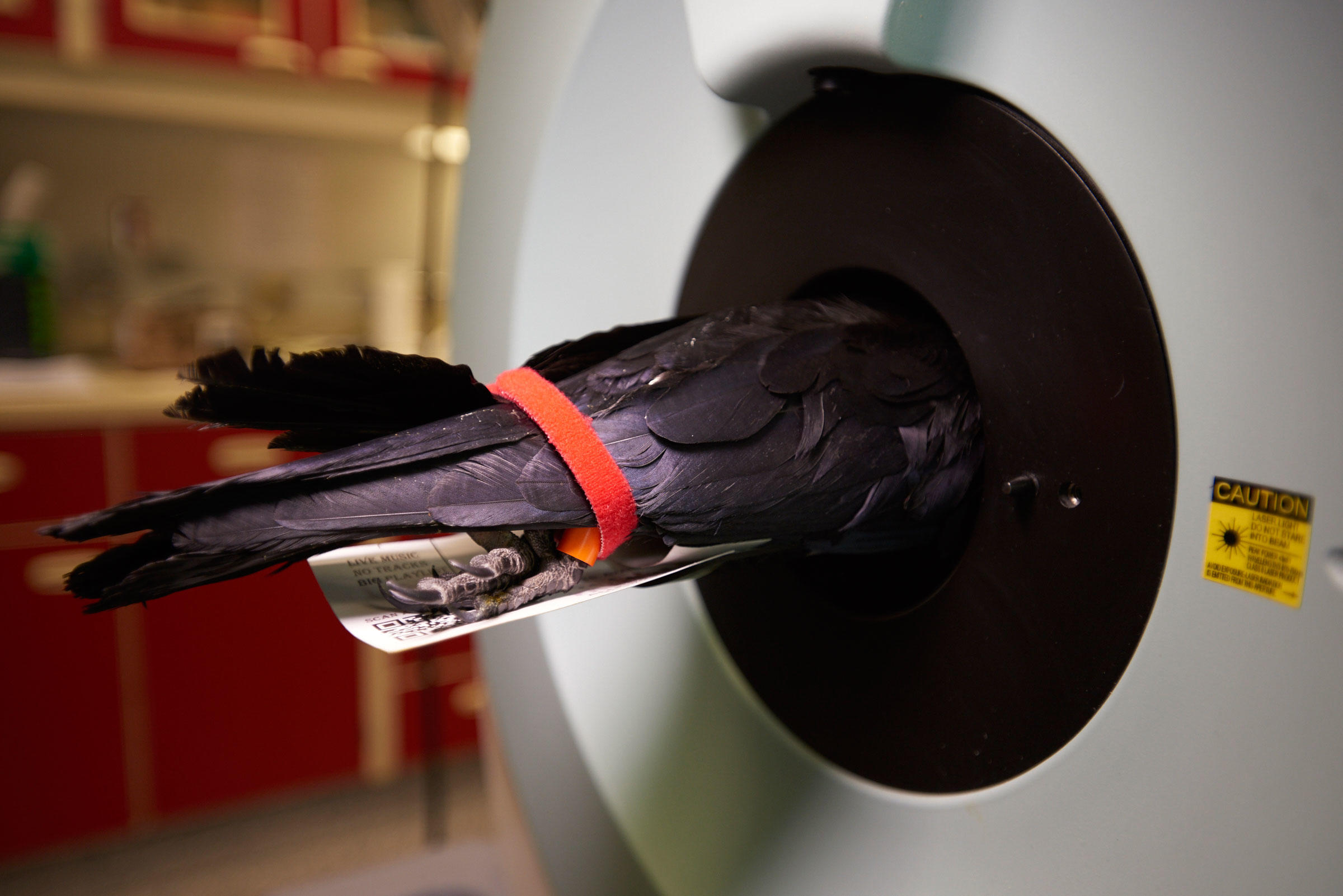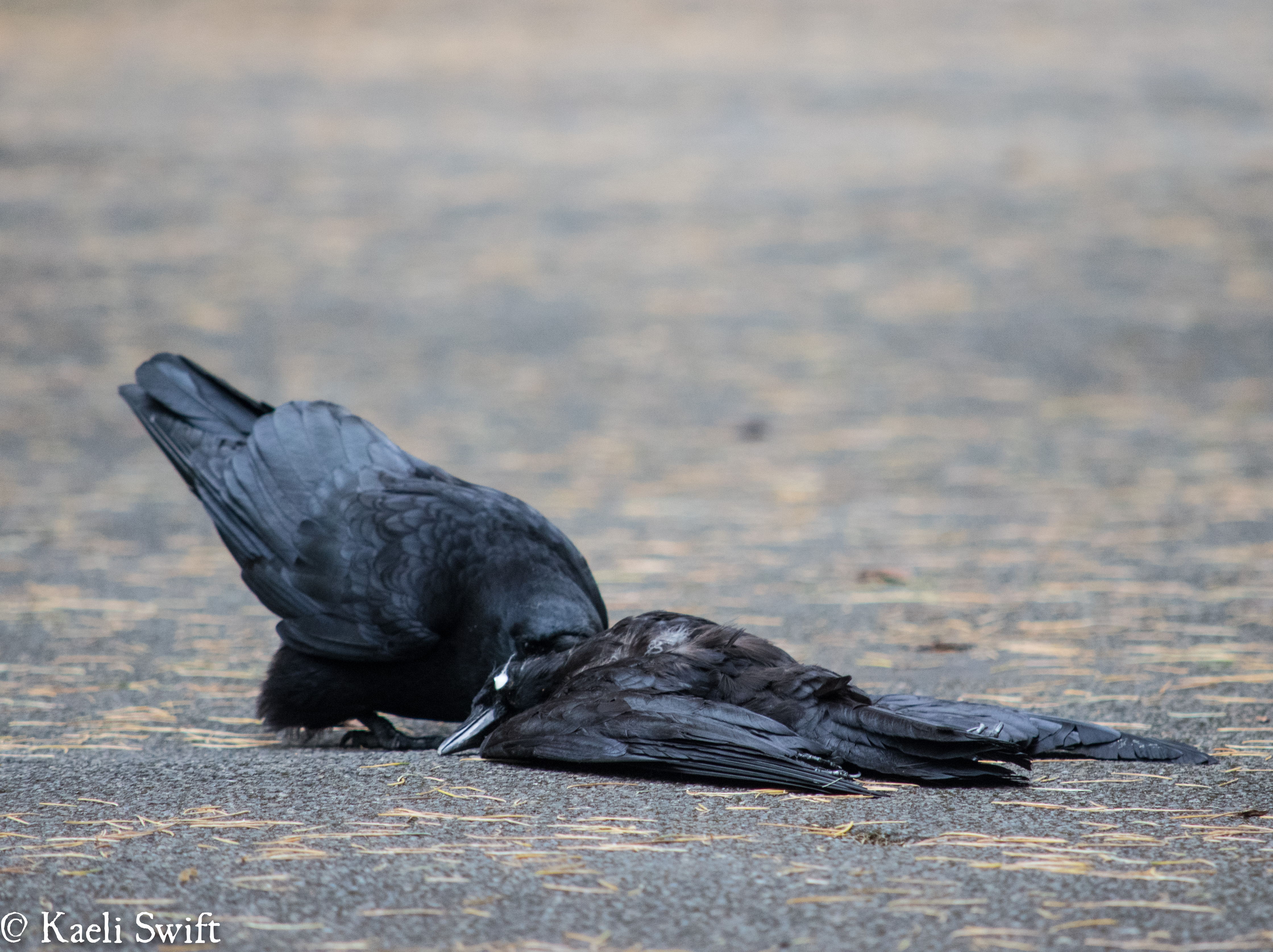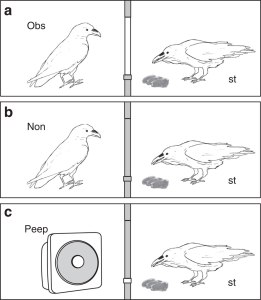As 2018 draws to a close, I want to dedicate a post to five of the most interesting and important publications about our favorite family of birds that came out this year. For the sake of a brevity, the reported studies are largely condensed with some tests/results omitted and little attention to normally key experimental elements like controls, statistical analyses, etc. Please click on the study title to be directed to the full publication.

1. Townsed AK, Frett B, McGarvey A, and Taff CC. (2018). Where do winter crows go? Characterizing partial migration of American Crows with satellite telemetry, stable isotopes, and molecular markers. The Auk 135: 964-974
Background: Depending on where you live, the answer to, “Do crows migrate?,” can be quite different. For example, most Seattle residents would probably say no, since large numbers of crows can be seen here year round, while someone in say, a southern Canadian province, may notice a sharp decline in the number of crows during the winter. That’s because crows are what’s know as “partial migrant species” meaning that within a population, some individuals may be migratory and others resident with more migratory strategies biasing in areas with harsh winters. Despite the role of partial migration in how scientists currently explain the evolution of complete migration, little is known about the phenomenon. Even elemental questions such as: is this behavior fixed or flexible within individuals, is it environmentally influenced, and how might species use it to adapt to changing conditions remain under-explored.
Methods: The study looked at two populations of overwintering crows: one in Ithaca, New York and a second in Davis, California. They used a combination of intrinsic (meaning originating in the body) and extrinsic (meaning originating outside the body) markers to track the movement and origin of their 18 tagged subjects over 2-4 years. The intrinsic makers included molecular and stable isotope data, and the extrinsic marker was a satellite tracking device that was attached to the bird via a light backpack. I won’t go into the details of the molecular and stable isotope data, but suffice it to say that stable isotopes were used to identify the place of origin via the unique properties of the local food and water that embed into an individual’s tissue and the molecular data was used to sex individuals and establish relatedness.
Key findings: Of the 18 tagged crows across both east and west coast populations, they found that almost 78% were migratory. This was a shock to me, TBH. I had no idea just how many crow were making these annual trips. The distance these birds traveled varied widely, with some going as “little” as 280 km (173 miles) and others as much as 1095 km (680 miles). Among resident birds, they found that individuals never ventured further than 25 km (15.5 miles) from the center of their breeding site. For both resident and migratory individuals they found that birds were very loyal to their breeding sites; returning to the same territory year after year. Given this finding, it should not be surprising to learn that individuals did not vary from year to year in whether they were migratory or not. Together these results offer clues to how crows may respond to climate and urbanization induced changes in temperature to their local environments.

2. von Bayern AMP, Danel S, Auersperg AMI, Mioduszewska B, and Kacelnik A. (2018). Compound tool construction by New Caledonian crows. Nature Scientific Reports 8
Background: For decades people considered the use of tools to be a uniquely human feature. Now we know that all sorts of animals, ranging from fish to monkeys, use tools and a handful of animals even create tools. Among the small number of animals that create tools, we have only seen wild individuals modifying a single object. For example, stripping a twig of small leaves or branches in order to probe small holes for insects. Whether any wild animal is capable of making compound tools, those made by combining seperate non-functional parts, is unknown. Even in captivity, this behavior only has limited observation in the great apes. Understanding what animals are capable of this complex task and how they achieve it, might give us insight into the evolution of our own exective functions.
Methods: This study used eight wild caught captive New Caledonian crows. Like many experiments involving novel objects, this one occurred over multiple different phases. In phase I the birds were provided a long stick and a baited test box where food was within reach when using the stick, but not without it. In phase II the birds were presented with the same baited test box, except that instead of a single long stick, they were given a hollow cylinder and a second, thinner cylinder that needed to be combined in order to generate a tool long enough to reach the food. In phase III, the birds were given the same problem, only now with novel combinable items. In phase IV, the researchers tested whether the birds were combining elements because they understood that they needed to, or if because they derived some other benefit from the process. To do this, they presented birds with a bait box that had two tracks: one where the food was within reach of a single element and one where it required a compound element. In the final phase, birds were presented a bait box that required the combination of more than two elements.

Image from von Bayern et al. 2018
Key findings: All birds passed the initial tool use phase handily. Given that New Caledonian crows frequently use single element tools in the wild, this was not at all surprising. In the second phase, half of the subjects (four) were able to combine the two elements after no more than two failed attempts. These subjects were then able to transfer this knowledge when presented novel combinable objects. When given a bait box with food presented on the close and far tracks, birds most often only made compound tools when it was necessary, suggesting that they don’t do it just for fun. In the final phase, only one bird succeeded in making a tool that required more than two elements. These findings demonstrate that New Caledonian crows are not only on par with what’s know about compound tool use in the great apes, but actually exceed them.
Unfortunately what this study does not explicitly answer is whether the birds were able to create the needed tools as a result of mental mapping (i.e imagining the correct tool and how it might be assembled) or by happy accident. Without this knowledge, what their ability to make compound tools suggests about the evolution of things like insight remains mysterious. Given all the other remarkable ways New Caledonian crows show innovation when it comes to tool use, however, both myself and the authors of this study are hedging that it’s indeed cognition behind these behaviors rather than more simple mechanisms.
3. Boeckle M, Szipl G, and Bugnyar T. (2018). Raven food calls indicate sender’s age and sex. Frontiers in Zoology 15
Background: One of the most frequent inquiries that come my way are requests to decipher various crow calls. Given all we know about crows, this doesn’t seem like such an impossible request, but the reality is that crow communications remains one of the most impenetrable black boxes of crow behavior. I’ll save more on this for a future post dedicated to an upcoming publication by my colleague Loma Pendergraft, who spent his MS learning this fact the hard way. But suffice it to say that any progress on this front in the various Corvus species is groundbreaking news. We do, however, know more about raven calls. For example long “haa” calls are thought to recruit other individuals to sources of food. What was unknown at the start of this study was whether these calls encoded any class-specific information about the caller, such as their age or sex. Calls that impart class-level information about the caller have been previously demonstrated in some marmots and monkeys.
Methods: The researchers recorded hundreds of “haa” calls from wild ravens which had previously been color banded and whose age and sex were known. Using acoustic software they analyzed the vocalizations for patterns in call elements like frequency and inflection rate.
Key findings: As the study’s title suggests, ravens appear to encode information about their age and sex in “haa” food calls. For animals like ravens that live in “fission-fussion” social systems, meaning flexible social groups where individuals regularly reencounter familiar individuals, but also encounter unfamiliar ones, class-level information helps individuals quickly assess important aspects of a caller’s identity. Such information may be key to helping individuals decide if they want to join a feeding event or not. This decision is particularly important because aggression at feeding events can cause mortal injury, so grouping with a bad crowd can come at a high price.

4. Kroner A, and Ha R. (2018). An update of the breeding population status of the critically endangered Mariana Crow (Corvus kubaryi) on Rota, Northern Mariana Islands 2013–2014. Bird Conservation International 28: 416-422
Background: The Mariana crow or Aga is a native species to the islands of Guam and Rota. After the introduction of the brown tree snake to Guam in the 1940’s, Guam’s entire population of Aga were wiped out leaving only those found on Rota to continue the species. In 1982, the population hovered around 1,300 individuals but things were clearly in decline. In 1984 the Aga was officially listed as endangered and today is considered critically endangered by the IUCN. Unlike on Guam, there is no clear reason why the Aga continues to decline on Rota, though habitat loss, persecution by humans, natural disasters and introduced predators like cats likely all work together.
Methods: During 2013-2014 researchers counted breeding pairs by surveying all known island territories. During these counts (which took 845 hours of labor and traversed 1,485 hectares!) the researchers also documented any unpaired or subadult birds. Since the entire island could not be surveyed, to ultimately estimate the population size the researchers used models that accounted for missed detections.
Key findings: Spoiler alert: They are A BUMMER. In all that searching only 46 breeding pairs were detected. Accounting for unpaired birds and detection failures, the researchers estimate that the current population of Aga hovers around 178 individuals. Obviously that number alone is a gut punch but it’s especially true when you consider that that’s a 10-23% decline since 2007 and a 46-53% decline since 1998. Researchers estimate that at least 75 pairs are needed to maintain a viable population of Aga. Without intensive predator management and community level advocacy for these birds, their future is sadly looking grimmer and grimmer.
5. Walker LE, Marzluff JM, Metz MC, Wirsing AJ, Moskal ML, Stahler DR, and Smith DW. (2018). Population responses of common ravens to reintroduced wolves. Ecology and Evolution 8: 11158-11168
Background: One of the most persistent myths about common ravens is that they have a symbiotic relationship with grey wolves; intentionally showing them carcasses they find and then sharing in the bounty together. But while the case is actually that ravens are unwelcome dinner guests at the wolves’ table, there’s no question that the two species have profound effects on one another. The reintroduction of wolves to Yellowstone in 1995 therefore offers a valuable way to study how the presence of wolves affects the spatial distribution and feeding behaviors of park ravens.
Methods: This study was a collaborative effort between avian and spatial ecologists at the University of Washington and Yellowstone wolf biologists. Using data from 2009-2017 on wolf abundance and prey kills, and raven surveys taken both within the interior of the park and at anthropogenic food sources in surrounding areas (ex: the Gardner town dump), the researchers were able to model raven abundance during both the study period and before the reintroduction of wolves. I won’t go into the details of how these models are created, but suffice it to say that their purpose is to take the data you give them and find what predictors best explain your observed outcomes. For example if, say, you have a bunch of data about where ravens were located at different times, and have data on different possible predictors, say, wolf abundance, weather, carcass abundance, carcass biomass, and distance to anthropogenic food, etc., the right model could help you identify that carcass biomass is the best predictor of raven abundance.
Key findings: Previous studies have demonstrated that wolves make more kills during severe winters with higher snowpack, because prey have a more difficult time evading them. As a result, the researchers hypothesized that ravens would depend more heavily on wolf kills during severe winters, but this is not what they found. Instead, Yellowstone ravens seem to lean more on consistent, anthropogenic food sources during tough winters, but lean more on wolf provided carrion during more mild winters. Still, the presence of wolves has increased and stabilized the number of ravens in the park, because they provide a second year-round source of food, in contrast to human hunter provided kills which are seasonally limited. These findings are yet another demonstration of the value of top carnivores in stabilizing food webs and providing food for a cascade of creatures.

6. And as a bonus let’s not forget the most important 2018 study of them all, “Occurrence and variability of tactile interactions between wild American crows and dead conspecifics,” which you can read all about here. 😉





























